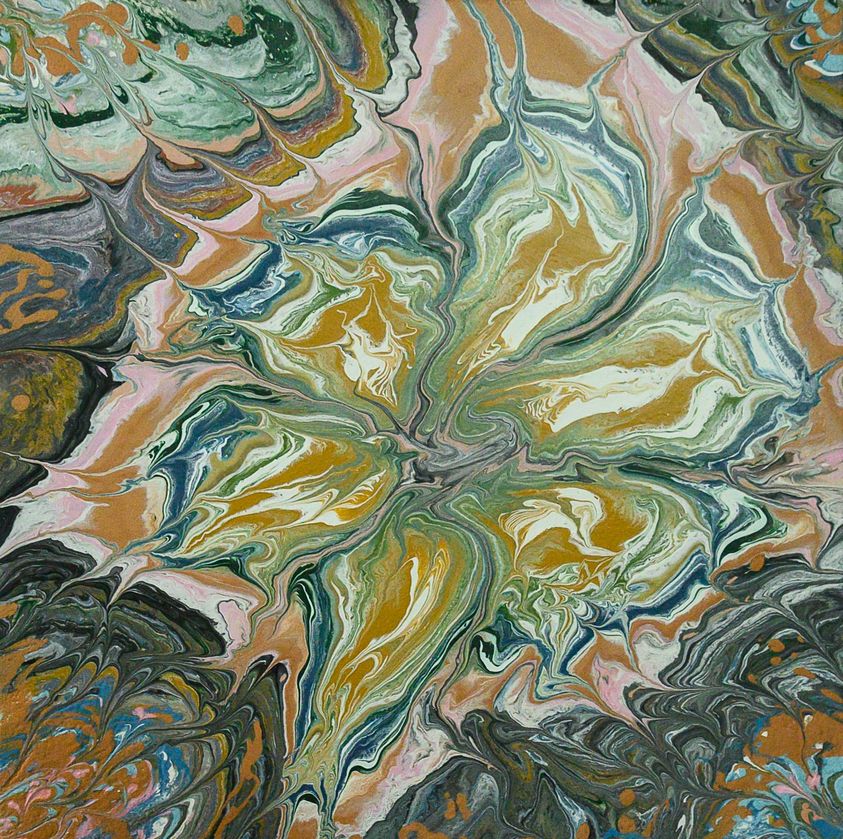Mastering the Pouring Art (the acrylic pouring) using it as a technique to express the emotional wave evoked by the symbol: this is the research of Elisabetta Maniaci, aka Eliz M which refers to Pollock's Action Painting, but reflects the peculiar traits of the territory - Montelepre - in the hinterland of Palermo. Sicily, in fact, is not just sea, horizons of turquoise waters and skies of a clear and deep blue. It is a land made up of very ancient memories, of evident signs of geological transformations: it is the center of the entire Mediterranean. In turn, Montelepre, which is perched on the slopes of a rich and still unexplored archaeological site, has been for centuries a strategic hub and observation point for what happened in the large and majestic surrounding valleys. It was so important that in the classical age a community flourished right up to the summit of Monte d'Oro, which still dominates the town. Eliz M focuses her attention on two directions: the metamorphic sign of time and the point of maximum visual stability. Therefore, analyse the fracture line and the intersection of the diagonals, the center. In her works we see both aspects returning with constant coherence. The center is first of all a life experience: Monte d'Oro donates infinite archaeological treasures to the community; from the minting of coins to ceramic fragments, the decorative apparatus is never perspective. The center coincides with the point of maximum interest, from this the wave of interest catches the eye - in the physical and emotional space. Historically in the Renaissance the village itself proliferated and developed around the watchtower, built by the bishop of Monreale to whom the territory belonged. The sacred mountain guardian of secrets, on which the inhabitants still climb annually in a devout and Christian procession, the fragments of classicism dispersed in the clay of the high pastures, the tower around the houses and where the inhabitants sought protection: everything was the center and the center was safety. Just as the traces of culture have left an imprint, those of the territory have also shaped the imagination: Montelepre is a land of quarries, of limestone that has marine origins and the pearly beauty of marble. In the cut stone slab, what strikes the observer, is the beauty and the hidden logic of the grain. It appears decorative, in reality it is the crystallized reflection of geological eras and immense forces whose power is still felt. This white veined body emerges from the sides of the open and stretched mountains, just as in the fields of mountain agriculture, where it is not flatness but diversity. Olive grove on the slope, orchard in the plain, agile reeds moved by the wind where the earth bends and sinks, collecting the dampness of the valley: each reality is defined, each has its own character. These are backgrounds that are placed side by side without mixing. Geology on the one hand and forgotten cultures that suddenly resurface: these traits of personal experience for Eliz M become generating elements of her visual imagination. In between there is the sensitivity of a woman who finds in the seasonal nature a continuous reference to these millenary elements. In the flowers there is the same centrality and symmetry: in the capsule of a poppy ready to release the seeds, in the section of a fruit, in the rays of a corolla. In the cultivated areas and above all in the uncultivated areas, the texture of the earth can be seen, marked by shadow gorges, by retaining walls, by small hidden streams, by well-tended rows that give way to pastures on the sunny, burnt and stony slopes. There is always a limit that changes color, a line that becomes arabesque, but it is more a fracture than a habit, a marked center that breaks down into symmetrical reflections: these are elements on which Eliz M insists moving the pigment with bamboo sticks, with small spatulas and other slender tools capable of defining the visual object - whether line or point - leaving the evanescent softness that this technique allows on the periphery. Thus, from the statement, the symbol or the idea, the surface of the work opens to receive its reflection, the chromatic wave, where everything is left free to recombine in precious iridescences, daughters of chemistry and gravity. Massimiliano Reggiani with the collaboration of Monica Cerrito

